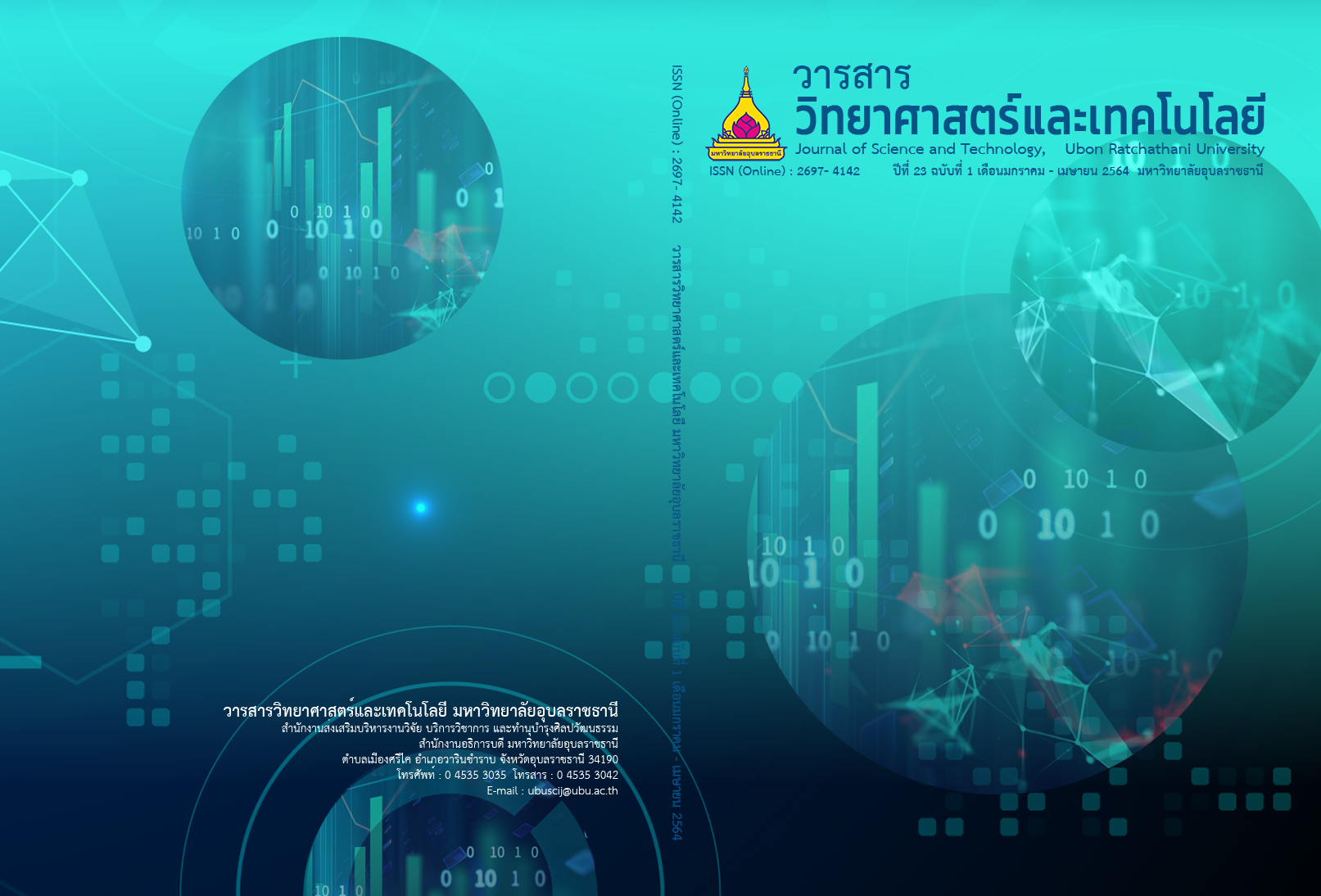ผลของระดับอุณหภูมิ ความเค็ม ต่อจำนวนการสืบพันธุ์แบบไม่อาศัยเพศและจำนวนเอฟิร่าแมงกะพรุนถ้วยหลากสี Catostylus townsendi (Mayer, 1915)
Main Article Content
บทคัดย่อ
การทดลองในครั้งนี้มีวัตถุประสงค์เพื่อศึกษาระดับอุณหภูมิ (26, 28 และ 30 องศาเซลเซียส) ความเค็ม (20, 25 และ 30 ส่วนในพัน) ต่อจำนวนการสืบพันธุ์แบบไม่อาศัยเพศ จำนวนสตรอบิล่าและจำนวนเอฟิร่าของแมงกะพรุนถ้วยหลากสี Catostylus townsendi (Mayer, 1915) เริ่มทำการทดลองตั้งแต่ระยะโพลิปและสิ้นสุดการทดลองหลังพบเอฟิร่า ผลการทดลองพบว่าการสืบพันธุ์แบบไม่อาศัยเพศของแมงกะพรุนถ้วยหลากสี มีรูปแบบการสืบพันธุ์แบบโพโดซีสต์ ผลของอุณหภูมิร่วมกับความเค็มต่อการสืบพันธุ์แบบไม่อาศัยเพศ สูงที่สุดที่ระดับอุณหภูมิ 26 องศาเซลเซียส ร่วมกับความเค็ม 25 ส่วนในพัน มีค่าเฉลี่ย 2.00±0.57 โพโดซีสต์ ผลของอุณหภูมิและความเค็มต่อการสืบพันธุ์แบบไม่อาศัยเพศ สูงที่สุดที่ระดับอุณหภูมิ 26 องศาเซลเซียส มีค่าเฉลี่ย 1.33±0.37 โพโดซีสต์ และสูงที่สุดที่ระดับความเค็ม 25 ส่วนในพัน มีค่าเฉลี่ย 0.88±0.35 โพโดซีสต์ จำนวนการเกิดสตรอบิล่ามีจำนวนสตรอบิล่ามากที่สุดที่ระดับอุณหภูมิ 30 องศาเซลเซียส ร่วมกับความเค็ม 20 และ 25 ส่วนในพัน มีค่าเฉลี่ย 4.33±0.33 ครั้ง ผลของอุณหภูมิและความเค็มต่อจำนวนการเกิดสตรอบิล่ามากที่สุดที่ระดับอุณหภูมิ 30 องศาเซลเซียส มีค่าเฉลี่ย 3.55±0.44 ครั้ง และมากที่สุดที่ระดับความเค็ม 20 ส่วนในพัน มีค่าเฉลี่ย 3.55±0.41 ครั้ง และพบจำนวนเอฟิร่าที่เกิดขึ้นมากที่สุดที่ระดับอุณหภูมิ 30 องศาเซลเซียส ร่วมกับความเค็ม 20 ส่วนในพัน มีค่าเฉลี่ย 14.66±1.33 เอฟิร่า ผลของอุณหภูมิและความเค็มต่อจำนวนเอฟิร่า พบจำนวนเอฟิร่ามากที่สุดที่ระดับอุณหภูมิ 30 องศาเซลเซียส มีค่าเฉลี่ย 10.66±1.57 เอฟิร่า และพบจำนวนเอฟิร่ามากที่สุดที่ระดับความเค็ม 20 ส่วนในพัน มีค่าเฉลี่ย 10.77±1.50 เอฟิร่า
Article Details
บทความที่ได้รับการตีพิมพ์เป็นลิขสิทธิ์ของ วารสารวิทยาศาสตร์และเทคโนโลยี มหาวิทยาลัยอุบลราชธานี
ข้อความที่ปรากฏในบทความแต่ละเรื่องในวารสารวิชาการเล่มนี้เป็นความคิดเห็นส่วนตัวของผู้เขียนแต่ละท่านไม่เกี่ยวข้องกับมหาวิทยาลัยอุบลราชธานี และคณาจารย์ท่านอื่นๆในมหาวิทยาลัยฯ แต่อย่างใด ความรับผิดชอบองค์ประกอบทั้งหมดของบทความแต่ละเรื่องเป็นของผู้เขียนแต่ละท่าน หากมีความผิดพลาดใดๆ ผู้เขียนแต่ละท่านจะรับผิดชอบบทความของตนเองแต่ผู้เดียว
เอกสารอ้างอิง
Journal. 616(1): 247–258.
[2] Straehler-Pohl, I., Widmer, C.L. and Morandini, A.C. 2011. Characterizations of juvenile stages of some semaeostome Scyphozoa (Cnidaria), with recognition of a
new family (Phacellophoridae).Zootaxa Journal. 2741: 1–37.
[3] Arai, M.N. 1997. A functional biology of scyphozoa. (p.1-316). New York: Chapman & Hall.
[4] Delap, M. J., 1905. Notes on the rearing, in an aquarium, of Cyanea lamarcki, Pe´ron & Lesueur. In: Report of Sea and Fisheries Ireland (1902–3), Scientific
Investigations 20–22, pl. I–II.
[5] Dong, J., Sun, M., Wang, B. and Liu, H. 2008. Comparison of life cycles and morphology of Cyanea nozakii and other scyphozoans. Plankton Benthos Research
Journal. 3: 118-124.
[6] Schiariti, A., Morandini, A. C., Jarms, G. and et al. 2014. Asexual reproduction strategies and blooming potential in Scyphozoa. Marine Ecology Progress Series
Journal. 510: 241-253.
[7] Widmer, C.L. 2008. Life Cycle of Chrysaora fuscescens (Cnidaria: Scyphozoa) and a Key to Sympatric Ephyrae. Pacific Science Journal. 62(1): 71-82.
[8] Choosri, S., Luangoon, N., Charoendee, W. and et al. 2016. Life cycle of the jellyfish Catostylus sp. http://dspace.lib.buu.ac.th
/xmlui/handle/1234567890/3658.Accessed 1 January 2021. (in Thai)
[9] AZA Aquatic Invertebrate TAG.2013. Jellyfish care manual. Association of Zoos and Aquariums, Silver Spring, MD.
[10] Tronolone, V. B., Morandini, A.E. and Migotto, A.E. 2002. On the occurrence of scyphozoan ephyrae(Cnidaria,Scyphozoa, Semaeostomeae and Rhizostomeae)
In: The southeastern Brazilian coast. Biota Neotropica. (pp.1-18).
[11] Willcox, S., Moltschaniwskyj, N.A. and Crawford, C. 2007. Asexual reproduction in scyphistomae of Aurelia sp.: Effects of temperature and salinity in an
experimental study. Experimental Marine Biology and Ecology Journal. 353(1): 107-114.
[12] Purcell, J. E.,Atienza, D., Fuentes, and et al. 2012. Temperature effects on asexual reproduction rates of scyphozoan species from the northwest Mediterranean
Sea. Hydrobiologia Journal. 690(1): 169–180.
[13] Calder, D.R. 1982. Life history of the cannonball jellyfish, Stomolophus meleagris L. Agassiz, 1860 (Scyphozoa, Rhizostomida). Biological Bulletin (Woods Hole)
Journal 162: 149-162.
[14] Silverstone, M., Tosteson, T.R. and Cutress, C.E. 1997. The effect of iodide and various iodocompounds on initiation of strobilation in Aurelia, Gen. Camp.
Endocrinol Journal. 32: 108–113.
[15] Keen, S. and Gong, A. 1989. Genotype and feeding frequency affect clone formation in a marine cnidarian (Aurelia aurita, Lamark 1816). Marine Ecology
Journal. 3: 735–745.
[16] Holst, S., and Jarm, G. 2010. Effects of low salinity on settlement and strobilation of scyphozoa (Cnidaria): Is the lion’s mane Cyanea capillata (L.) able to
reproduce in the brackish Baltic Sea? Hydrobiologia Journal. 645(1): 53-68.
[17] Pitt, K.A. 2000. Life history and settlement preferences of the edible jellyfish Catostylus mosaicus (Scyphozoa: Rhizostomeae). Marine Biology Journal. 136(2):
269-279.
[18] Jarms, G. 1990. Neubeschreibung dreier Arten der Gattung Nausithoe (Coronata, Scyphozoa) sowie Wiederbeschreibung der Art Nausithoe marginata Ko¨
lliker, 1853. Mitteilungendes Hamburger Zoologischen Museums und Instituts 87: 7–39.
[19] Purcell, J.E., White, J.R., Nemazie, D.A. and Wright, D.A. 1999. Temperature, salinity and food effects on asexual reproduction and abundance of the scyphozoan
Chrysaora quinquecirrha. Marine Ecology Progress Series Journal. 180: 187-196.
[20] Purcell, J. E. 2007. Environmental effects on asexual reproduction rates of the Scyphozoan, Aurelia labiata. Marine Ecology Progress Series Journal. 348: 183–
196.
[21] Purcell, J.E. and Decker, M.B. 2005. Effects of climate on relative predation by ctenophores and scyphomedusae on copepods in Chesapeake Bay during 1987–
2000. Limnology and Oceanography Journal. 50: 376–387.
[22] Phuangsanthia, W. (2017). Life cycle and effect of temperature, salinity on asexual reproduction of a Rhizostome Jellyfish scyphistoma, Acromitus flagellatus
(Maas, 1903) under laboratory condition. M.SC.Thesisi, Burapha University. (in Thai)
[23] Office of Science and Technology Royal Thai Embassy. 2019. Science and Technology Royal Thai Embassy. https://www.thai
science.eu/uploads/journal_20190827152603-pdf.pdf. Accessed 1 January 2021. (in Thai)


